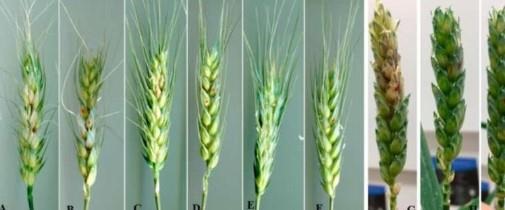A naturally occurring virus co-discovered by Agricultural Research Service (ARS) and university scientists may offer a way to undermine a costly fungal threat to wheat, barley and other small-grain crops.

Photos showing typic symptoms of FHB on spikes of wheat genotype NIL-S (A–F) and Y1193-06 (G–I) one (in case of Y1193-06) or two weeks (in case of NIL-S) post inoculation with the F. graminearum isolate Fg-4-1 (A,B,G), Fg-4-2 (C,D,H), or water (E,F,I). Red spots indicate the inoculated spikelets. Credit: Microorganisms (2022).
The fungus, Fusarium graminearum, is the chief culprit behind a disease called Fusarium head blight, or "scab." Unchecked with fungicides or other measures, scab diminishes the yield and quality of the crops' grain. Under wet, humid conditions, the scab fungus can release a toxin called deoxynivalenol (a.k.a., "vomitoxin") that can contaminate the grain, reducing its point-of-sale value or leading to outright rejection depending on end use.
Now, however, a team of scientists with the ARS Application Technology Research Unit in Wooster, Ohio, and South Dakota State University in Brookings (SDSU) has discovered a strain of a fungal virus, or "mycovirus," that disables the scab fungus's vomitoxin-making machinery.
In nature, the mycovirus, a species called Fusarium graminearaum Vg1, infects the scab fungus to replicate and spread. But the new mycovirus strain, dubbed F. graminearum Vg1-SD4, takes such attacks a step further by stopping the scab fungus from making vomitoxin—a fortuitous benefit for wheat plants.
Indeed, in laboratory and greenhouse experiments, cultures of the scab fungus that had been infected with the mycovirus strain grew slower than non-infected cultures and produced no vomitoxin in the grain of susceptible potted wheat plants. In contrast, the grain of wheat plants exposed to mycovirus-free cultures of scab contained 18 ppm of vomitoxin, a byproduct of the fungus's metabolism that can be harmful to livestock and human health.
Click here to see more...